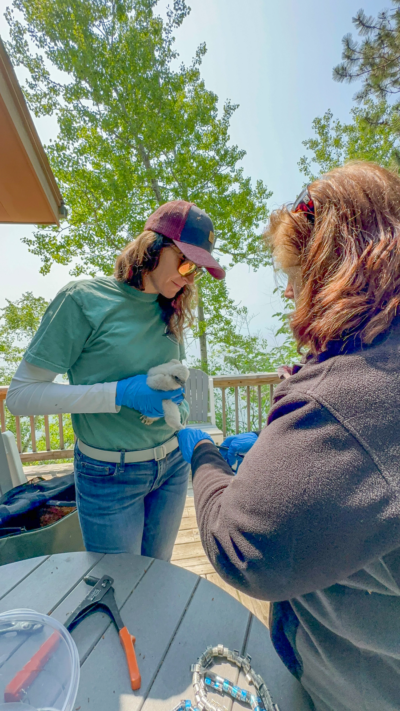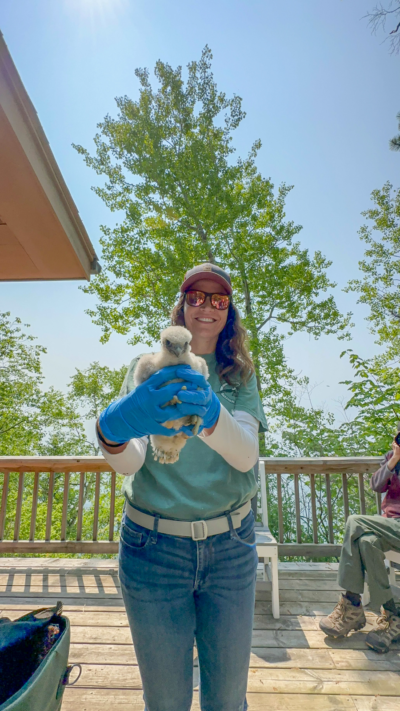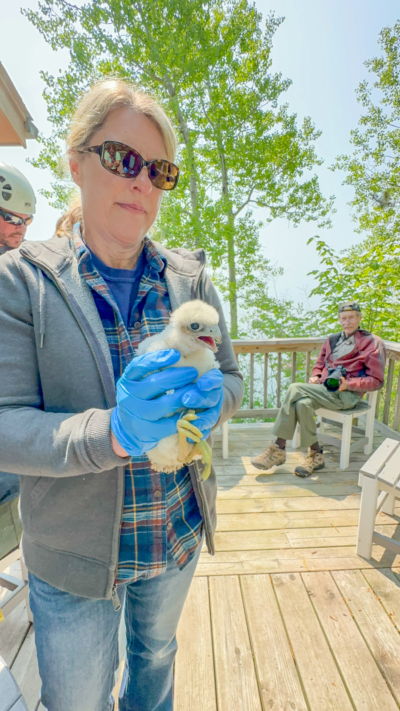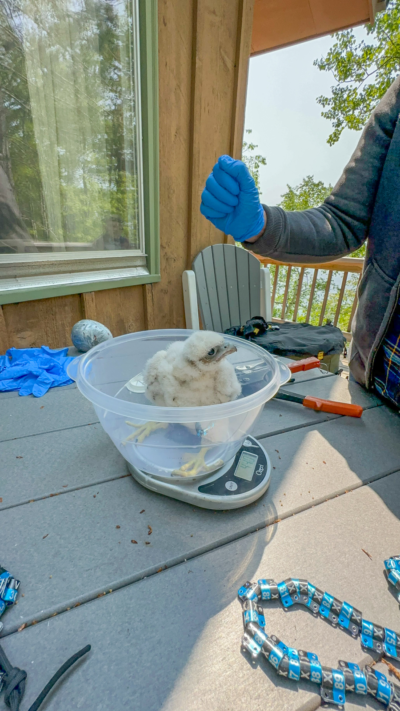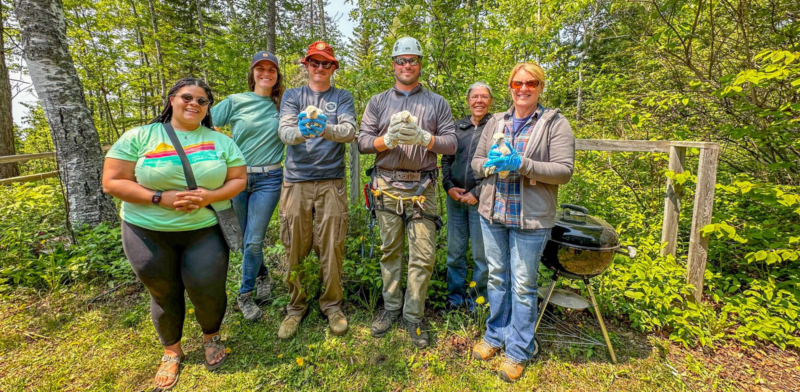
In early June, two guests walked into the Cascade Vacation Rentals’ office with an interesting story. The guests were staying at Cathy’s Cove, a small cabin on Lake Superior near Tofte, Minnesota. The cabin has a small cove beach area that is a favorite amongst past guests at Cathy’s Cove. Only, these guests were not able to get down to enjoy the cove area. This was due to a falcon suddenly appearing and dive-bombing the guests as they approached the bottom of the staircase leading to the cove. This was unusual. We had not heard about a falcon dive-bombing guests at any of our properties before! We decided to investigate and quickly learned that a pair of peregrine falcons had made their home and hatched three chicks on the steep cliffs surrounding Cathy’s Cove. This family of five has become known as Cathy’s Cove Peregrine Falcons.
As we approach the falcon’s second month of life, they are expected to fledge soon. Before that happens, they need names. This is where you come in. Help us name our Peregrine Falcon chicks! Learn more about the falcons, all about their banding adventure, and learn how you can have a chance to name one of the three Cathy’s Cove chicks!
About Peregrine Falcons
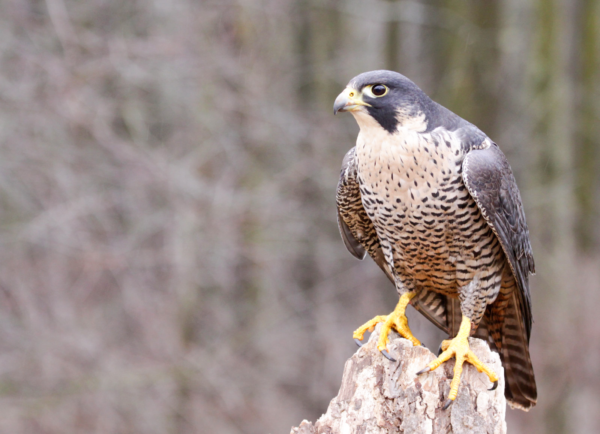
According to the National Park Service:
The American peregrine falcon is one of the best known raptors in North America. There are three subspecies of peregrines in North America: the American or continental peregrine falcon (Falco peregrinus anatum), the tundra or arctic peregrine falcon (Falco peregrinus tundrius), and the Peale’s peregrine falcon (Falco peregrinus pealei).
Many people are aware of the population declines of this species due to problems with egg-shell thinning caused by persistent organic pollutants such as DDT. Populations of this species were driven to the brink of extinction and the peregrine falcon was federally listed as an endangered species in 1973. Reducing DDT in our environment provided peregrine falcons with a chance to recover and the population in Alaska has grown rapidly from 1980 to the present. The American peregrine falcon was removed from the endangered species list in 1999.
The peregrine falcon is one of nature’s swiftest and most beautiful birds of prey. Its name comes from the Latin word peregrinus, meaning “foreigner” or “traveler.” This impressive bird has long been noted for its speed, grace, and aerial skills. Now, it is also a symbol of America’s recovering threatened and endangered species.
Peregrine Falcon Aggressive Nature
Upon learning that we had peregrine falcons at one of our properties, we immediately reached out to the Midwest Peregrine Society to figure out what to do. Through them, we learned some information about their behaviors, especially when they have hatchlings nearby. From Jackie Fallon of the Midwest Peregrine Society:
The recovery of the peregrine falcon (Falco peregrinus) has been celebrated by many, as one of our most successful endangered species programs in North America. With that success, we now have challenges when defensive peregrines interact with building staff, tenants, and neighboring building management teams. This most often occurs during the nesting and fledgling season, which tends to be March through August in Minnesota.
Peregrines are naturally defensive of their territory, and they direct that aggression toward other falcons or anything (or anyone) they view as an intruder. There are numerous reasons for defensive behavior, but this is due primarily to increased hormone levels and the “value” of the territory or area surrounding the nest due to eggs and offspring.
Defense of the area can be exhibited by vocalizations, a change in body posture with the vocalizations (appearing larger and more threatening), or direct and powerful flights. Often, these flight displays begin with the falcon making high passes or stoops toward the “intruder”, without any intention of actually striking them. When the falcon exhibits these behaviors, the human may quickly leave the area and therefore the falcon may interpret this action as one of defeat and the falcon “winning” the encounter. Over time, if the threat displays fail to deter a perceived intruder, then the bird may heighten the intensity of the behavior. This may increase to the point of physically striking the intruder, which can be serious and cause injury. There are also varying degrees of intensity of the behavior, based on the individual falcon themself.
This behavior perfectly matched that of the Cathy’s Cove peregrine falcons that our guests had observed. Recognizing this may mean there were some chicks nearby, the Midwest Peregrine Society gave us some suggestions, which we have abided by. We closed access to the cove and alerted incoming guests. Neither the male nor female adult peregrine falcon seemed to be agitated by guests being in the home, on the deck, or in the yard around the home. So, Cathy’s Cove remained open for the summer, with incoming guests warned to keep a safe distance and not go on the stairs to the cove.
Discovering and Banding the Three Peregrine Falcon Chicks
The Midwest Peregrine Society came out immediately to confirm their suspicion that the Cathy’s Cove Peregrine Falcons were a pair missing from another area near Tofte. Through observation of the male, they learned that he is Rolling Thunder, who had hatched on Palisade Head in 2019. He and his mate, who was not banded and does not have a name, were the peregrines that had gone missing from the Tofte area the year previous. It seems the pair decided to hatch their chicks on the cliff’s around Cathy’s Cove and likely settled in the area sometime in March and April. We believe they laid four eggs resulting in three hatchlings in late May and early June.
On June 16, a team of volunteers descended upon Cathy’s Cove to retrieve, band, and weigh the three chicks. In an experience unlike any other, several of Cascade Vacation Rentals’ employees were able to observe the banding and see the chicks up close. Banding allows peregrine societies to further study and understand peregrine falcons in today’s environment, understand their biology, and monitor the population. This also allows them to study migration behavior, survivorship, reproductive success, etc. The Midwest population of peregrine falcons is the most heavily studied wildlife population in the world, with over 11,000 falcons banded over the past 41 years! That number includes the father of this falcon family, Rolling Thunder.
Jim Mussell and Erik Shefland were the climbers for the day’s banding. Jackie Fallon did the banding. Amber Thompson, Colin Anderson, and Jenny Prom assisted with the chicks. We also learned during the banding that peregrines historically nest on tall cliffs in the region, on Lake Superior and the Mississippi River. They are drawn to tall places near water. Falcons do not build a nest but rather use a rock ledge to lay their eggs. Today, they will also nest in artificial nest boxes on tall buildings, bridges, and smokestacks. Although the cliff at this cove isn’t as tall as Palisade Head, it is a great spot to nest.
This potentially once-in-a-lifetime opportunity to observe the banding process was one we won’t soon forget. Especially because we learned during the banding that we have the opportunity to name the three falcons! This, friends and guests of Cascade Vacation Rentals, is where you come in!
Help Us Name the Cathy’s Cove Peregrine Falcons
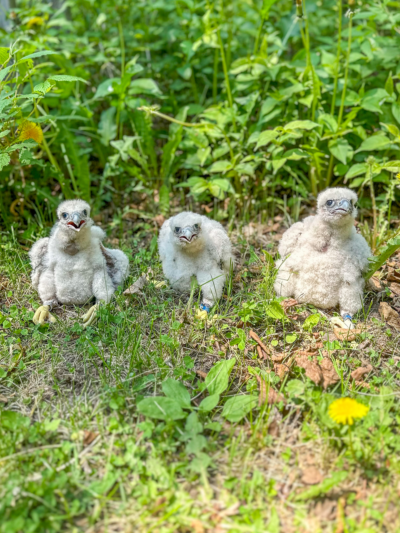
Chick #3, Chick #2, and Chick #1
That’s right! We get to name the three baby chicks! From the banding, we learned the following information about the chicks:
Chick #1 is a Boy who weighed 496 grams and was 17 days old on Banding Day. Banding #1266-14905. (Right in Photo)
Chick #2 is a Boy who weighed 440 grams and was 16 days old on Banding Day. Banding #1266-14906. (Center in Photo)
Chick #3 is a Girl who weighed 470 grams and was 15 days old on Banding Day. Banding #1266-14907. (Left in Photo)
Keeping in mind that Dad’s name is Rolling Thunder and Mom is not named, we need help naming the three chicks! They were born at Cathy’s Cove in May and June 2023.
We have some ideas but wanted to see what names everyone else can come up with. Head on over to our TikTok (@staycvr), Facebook (Cascade Vacation Rentals), Instagram (@cascadevacationrentals), or our new Threads (@cascadevacationrentals) pages and find our Peregrine Falcon photos and videos and leave your name suggestions there. The posts will be available on the morning of Friday, July 14. You can give us a name suggestion for one or all three. Themed names are common, Rolling Thunder’s sister name is Hail Storm, for instance. We want to get the chicks named before they fledge, so we will pick a name at noon on Friday, July 21, and announce our picks on our social media pages. We will then submit the names to the Midwest Peregrine Society to add to their official records. Your name could live on for decades amongst peregrine falcon fans!
Cathy’s Cove Shoreline Closure
To help preserve this endangered species of falcons, the Cathy’s Cove shoreline access will remain closed until the chicks have fledged and Mom stops her aggressive actions to anyone who approaches the shoreline. Our staff is making weekly trips to the home to test out if this has happened yet. When it does, we will lift the ban on shoreline access. It is too soon to tell if Rolling Thunder and his mate will return in 2024 to hatch more chicks. If that does happen, the shoreline will once again be closed so they can fledge their chicks without feeling threatened. But, you can still rent the cabin and enjoy the beautiful Lake Superior views from the deck and yard area. And, be a part of the revitalization of the peregrine falcons. Cathy’s Cove may just become a new Birders Paradise on the North Shore!
More Photos From the Banding
